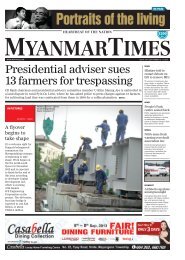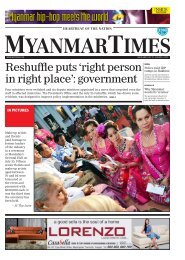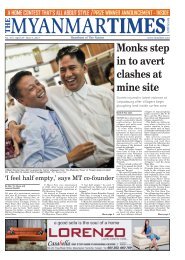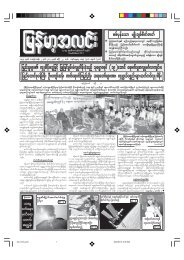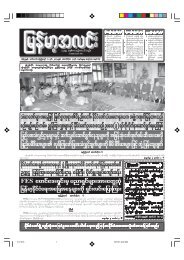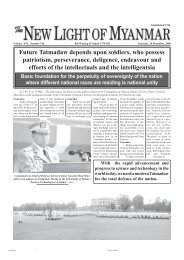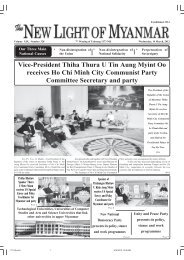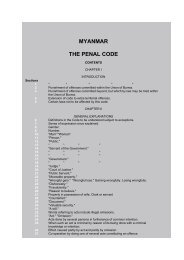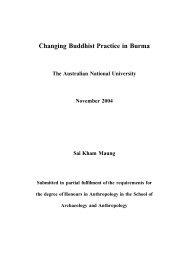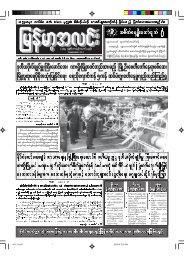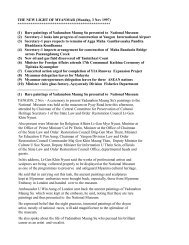Monday 8 April 2013 - Online Burma/Myanmar Library
Monday 8 April 2013 - Online Burma/Myanmar Library
Monday 8 April 2013 - Online Burma/Myanmar Library
Create successful ePaper yourself
Turn your PDF publications into a flip-book with our unique Google optimized e-Paper software.
8 <strong>Monday</strong>, 8 <strong>April</strong>, <strong>2013</strong><br />
New Light of <strong>Myanmar</strong><br />
Article<br />
Eco and Pilgrimage Touristic Attraction<br />
<strong>Monday</strong>, 8 <strong>April</strong>, <strong>2013</strong><br />
Sacred Man Shwe Set Taw Hill Range<br />
Mutual respect and<br />
understanding<br />
From the very start, we have already<br />
anticipated conflicts and difficulties may arise<br />
during our period of democratic transition. But<br />
with a united effort, we must brace and overcome<br />
these challenges in unity. As we rebuild our<br />
society, we must rise above decades of historical<br />
bitterness, confrontational approaches, and a<br />
zero-sum attitude in solving our differences.<br />
In this time of change towards an open<br />
society, the government is trying utmost to<br />
share information in a truthful and transparent<br />
manner.<br />
Moreover, the Constitution guarantees the<br />
right of all citizens to worship freely any religion<br />
they choose. So, we warn all political opportunists<br />
and religious extremists who try to exploit the<br />
noble teachings of these religions and have tried<br />
to foment hatred among people of different<br />
faiths for their own self-interest: their efforts<br />
will not be tolerated. We will take all necessary<br />
and effective action to stop their conspiracies<br />
in accordance with our Constitution and our<br />
existing laws. All perpetrators of violence will<br />
be prosecuted to the fullest extent of the law.<br />
Actually, it is only a very small minority<br />
of individuals who have been responsible for<br />
spreading rumors that could incite riots, causing<br />
fear among the general public who only wish<br />
to live peacefully. And we are very pleased to<br />
see local authorities, community and religious<br />
leaders coming together to form riot-prevention<br />
committees to protect the people.<br />
We are happy to see a concerted effort<br />
from civil society organizations, leaders of<br />
communities, government agencies and security<br />
forces to prevent the spread of conflict to other<br />
cities and towns. This indicates that citizens from<br />
different ethnic and religious groups are working<br />
together to create a peaceful society based on<br />
democratic norms and a proud nation that is<br />
based on mutual respect and understanding.<br />
There is a thriving<br />
trading town called Minbu<br />
in Magway Region, mid<br />
<strong>Myanmar</strong>. Twenty six<br />
miles to the south west of<br />
Minbu, runs the western<br />
Yoma hill range covered<br />
with thick forests and<br />
crisscrossed by brooks<br />
and streams. On the most<br />
easterly off shoot of this<br />
range are dotted religious<br />
edifices of different sizes<br />
and designs belonging to<br />
different ages of <strong>Myanmar</strong><br />
archaeology and history.<br />
Strange rock formation<br />
of the hill gave rise to<br />
legends and mysteries that<br />
came to acquire religious<br />
associations with the arrival<br />
of Buddha Sasana there.<br />
The tow most wellknown<br />
and reverently<br />
venerated religious<br />
monuments on this hill<br />
are Man set taw ya or Man<br />
Shwe Set Taw. “Set taw<br />
ya” means Buddha’s Foot<br />
Print. There are five kinds<br />
of pagodas depending on<br />
what they contain inside.<br />
(1) Dhatu Zedi, Pagoda in<br />
which mortal remains of the<br />
Buddha or Saint [such as<br />
hair, tooth, bones or bone<br />
ashes] were enshrined, (2)<br />
Dhamma Zedi, pagoda in<br />
which Buddha’s teachings,<br />
partly or wholly recorded<br />
on stone, wood, paper,<br />
metal or any material were<br />
enshrined (3) Paribawga<br />
Zedi, pagoda in which<br />
utensils such as alms bowl,<br />
bathing robe, staff, water<br />
strainer or couch etc. used<br />
by the Buddha or Saint<br />
monks were enshrined<br />
Deputy Information Minister meets<br />
chairmen, executives of MPPA, MPBSA<br />
Deputy Minister U Ye Htut addresses the meeting of Printers and Publishers<br />
Association and <strong>Myanmar</strong> Publishers and Book Sellers Association.—mna<br />
N a y P y i T a w, 7<br />
<strong>April</strong>—In meeting with<br />
chairmen and executives<br />
of <strong>Myanmar</strong> Printers and<br />
Publishers Association and<br />
<strong>Myanmar</strong> Publishers and<br />
Book Sellers Association at<br />
the meeting hall of Printing<br />
and Publishing Enterprise on<br />
(4) Udisa Zedi, pagoda<br />
in which images, statues,<br />
sculptors or painting in the<br />
likeness of the Buddha or<br />
saint monk were enshrined<br />
for worship and (5) Pada<br />
Zedi, pagoda in which foot<br />
print of the Buddha or saint<br />
monk were encased for<br />
veneration. Therefore, the<br />
two edifices on Minbu Hill<br />
Range are Pada zedis which<br />
interned two foot prints of<br />
the living Gotama Buddha<br />
which Buddhists believe<br />
to have been left there for<br />
veneration.<br />
The pleasant Minbu<br />
Hill Range, the unmatched<br />
glories of its natural<br />
landscape and the sublimity<br />
and sacredness of the two<br />
pada zedis were painted in<br />
words and poetic imageries<br />
of monk and lay writers of<br />
the Inwa period onwards in<br />
Maha Saddhamma Jotika dhaja<br />
Sithu Dr Khin Maung Nyunt<br />
<strong>Myanmar</strong> literary history.<br />
Notably three monk poets<br />
of Inwa Period, Shin Maha<br />
Silawintha in his Tada<br />
Uti Mawgun, Shin Maha<br />
Rahta thaya in his Mingala<br />
Zedi Mawgun and Shin<br />
Uttamakyaw in his Tawlar<br />
poem, composed verses of<br />
exceptional literary qualities,<br />
vividly describing their on<br />
food land journey from the<br />
capital Inwa to Minbu Hill<br />
Range on pilgrimage to<br />
the two Pada Zedis [Shwe<br />
set taw or Man set taw ya].<br />
Later in Konbaung Period<br />
[1752-1885 A.D] one noted<br />
monk Sayadaw of Minbu U<br />
Aubatha in his translation<br />
into <strong>Myanmar</strong> of Vessandara<br />
Jataka [Buddha’s birth<br />
story] was so inspiried by<br />
Theinbyu Road in Yangon<br />
today, Deputy Minister for<br />
Information U Ye Htut said<br />
that discussions on Printing<br />
and Publishing draft law<br />
were held with international<br />
organizations and foreign<br />
embassies in order to meet<br />
international standards.<br />
The deputy minister<br />
elaborated on discussions<br />
held with international<br />
organizations and foreign<br />
embassies, suggestions<br />
given by local media<br />
and civil societies and<br />
comparisons between<br />
provisions of the draft law<br />
and international norms<br />
and explained suggested<br />
points that will be submitted<br />
the natural beauties of his<br />
native place that he excelled<br />
in his description of the<br />
Himlalyan mountains and<br />
Winkaba forest into which<br />
Prince Vessandara, his wife<br />
Madi and son and daughter<br />
were exiled for some years.<br />
Of course U Aubatha had<br />
never been to Himalya<br />
Mountains. But as a native<br />
of Minbu he knew full well<br />
of Minbu Hill Range and<br />
the two pada zedis. So in<br />
his translation of Vessandara<br />
jataka, U Aubatha gave his<br />
vast knowledge of flora,<br />
fauna, geology, geography<br />
and forestry of Minbu<br />
Hill Range. His translated<br />
Vessandara Jataka was a<br />
prescribed text book for high<br />
school in British colonial<br />
days and two English head<br />
masters had translated it into<br />
English.<br />
Bagan, the capital of<br />
First <strong>Myanmar</strong> Union was<br />
founded on the east bank<br />
of the River Ayeyawaddy.,<br />
in central <strong>Myanmar</strong>. It had<br />
eleven economic zones in<br />
irrigated areas in Kyaukse<br />
about over 150 miles to<br />
the north east. Also there<br />
were six economic zones<br />
in Minbu area to the west,<br />
such as (1) Saku (2) Salin<br />
(3) Phaung Lin (4) Kyabin<br />
(5) Maypinsaya and (6) Lei<br />
Kaing. It was in Lei Kaing<br />
that the legend of the two<br />
pada zedis originated. In<br />
the time of living Gotama<br />
Buddha, the lands of the<br />
eastern bank of the River<br />
Ayeyawaddy were called<br />
Tampadipa—and those on<br />
its western bank were called<br />
to Pyithu Hluttaw Bill<br />
Committee.<br />
Chairman of <strong>Myanmar</strong><br />
Printers and Publishers<br />
Association Dr Tin Tun Oo<br />
and Chairman of <strong>Myanmar</strong><br />
Publishers and Book Sellers<br />
Association Dr Tha Tun<br />
Oo discussed that suggested<br />
amendments and suggestions<br />
regarding the draft law would<br />
be presented during the<br />
prescribed period. Next,<br />
those present took part in the<br />
discussions on the draft law.<br />
It was also attended by<br />
departmental heads of the<br />
Ministry of Information and<br />
officials, responsible persons<br />
of civil societies and media<br />
men. — MNA<br />
Thunaparanta. Lei Kaing<br />
in Thunaparanta was then<br />
known as Verneiksa gama<br />
[Big village of Traders].<br />
At that village lived two<br />
merchant brothers Maha<br />
Punna the elder and Cula<br />
Punna, the younger. They<br />
took by turn alternate dutiesif<br />
one went out overseas the<br />
other remained at home to<br />
look after their successful<br />
business. It was during<br />
his oversea journey to<br />
Maijimadesa [India] that<br />
the elder brother Maha Punna<br />
chanced to visit Gotama<br />
Buddha in Jetavana Vihara<br />
in Savatthi, and heard his<br />
Dhamma teachings. He<br />
requested the Buddha to<br />
come to his village for<br />
teaching. The Buddha<br />
agreed. Maha Punna returned<br />
home and with his younger<br />
brother and villagers built<br />
a big monastery for the<br />
Buddha and his disciple<br />
monks to reside when they<br />
arrived. As there was not<br />
enough time to cut down<br />
teak trees for building, they<br />
used sandal wood, because<br />
there were sandal wood trees<br />
grown profoundly in the<br />
neighbourhood. Originally<br />
sandal wood tree was brought<br />
from Malayu [Malaysia]<br />
by Cula Punna some years<br />
ago. The big sandal wood<br />
monastery had 108 large<br />
rooms, 1060 windows and<br />
100 flights of steps and<br />
roofed by elaborately carved<br />
spires. In Maha Sakarit year<br />
123, the 8 th ordained year<br />
of the Buddha, the Buddha<br />
and 500 monk disciples<br />
arrived and stayed in the<br />
big monastery to preach<br />
the Dhamma everyday for<br />
one week to the village<br />
community. Every early<br />
morning the Buddha made<br />
his routine round of receiving<br />
alms food.<br />
One morning, the<br />
Buddha met a naga serpent<br />
named Nammanda at the<br />
river [Today Man chaung<br />
stream]. Naga serpent invited<br />
the Buddha to his domain<br />
for Dhamma teachings.<br />
The Naga serpent and the<br />
community embraced the<br />
teachings. They requested<br />
the Buddha to give them his<br />
representa-tion to venerate<br />
whereupon the Buddha<br />
left his foot print on a mud<br />
bank at the foot of the Hill<br />
Range [now known as Auk<br />
Set tawya, Foot print below<br />
the hill].<br />
(See page 9)




